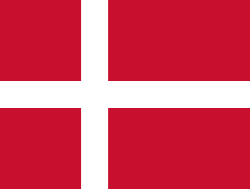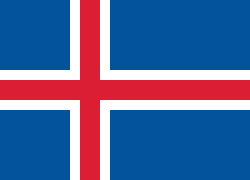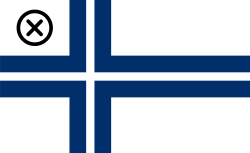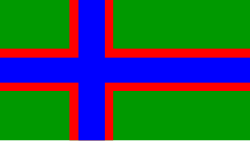Top Qs
Timeline
Chat
Perspective
Nordic cross flag
Flag bearing the design of the Nordic or Scandinavian cross From Wikipedia, the free encyclopedia
Remove ads
A Nordic cross flag is a flag bearing the design of the Nordic or Scandinavian cross, a cross symbol in a rectangular field, with the centre of the cross shifted towards the hoist.

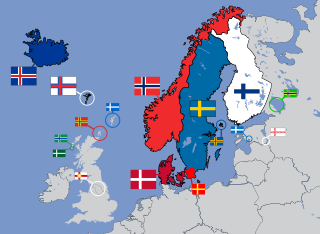
Larger flags, from left to right: Iceland, Faroe Islands, Denmark, Norway, Sweden, Finland;
Smaller flags, from left to right: Barra, South Uist, Yorkshire West Riding (historical), Orkney, Shetland, Scania, Åland, Pärnu, Setomaa (ethnic), Vepsians (ethnic).
All independent Nordic countries have adopted such flags in the modern period, and while the Nordic cross is named for its use in the national flags of the Nordic nations, the term is used universally by vexillologists, in reference not only to the flags of the Nordic countries but to other flags with similar designs.[1] The cross design represents Christianity,[2][3][4] and was first seen in the Dannebrog, the national flag of Denmark in the first half of the 13th century. The same design, but with a red Nordic cross on a yellow background, was used as union flag during the Kalmar union (1397 to 1523), and when that union fell apart in 1523 the same design, but with a yellow cross on a blue background (derived from the Swedish coat of arms adopted in 1442), was adopted as national flag of Sweden, while Norway adopted their flag in 1821. After gaining independence the other Nordic countries adopted national flags of the same design, Iceland in 1915 and Finland in 1918. The Norwegian flag was the first Nordic cross flag with three colours. All Nordic flags may be flown as gonfalons as well.
Remove ads
Flag formats
Flags of the Nordic countries
Summarize
Perspective
Some of these flags are historical. Also, flag proportions may vary between the different flags and sometimes even between different versions of the same flag.
The Flag of Greenland is the only national flag of a Nordic country or territory without a Nordic Cross. When Greenland was granted home rule, the present flag — with a graphic design unique to Greenland — was adopted in June 1985, supported by fourteen votes against eleven who supported a proposed green-and-white Nordic cross.[5]
Denmark
- Flag of Denmark (1748)
- State flag of Denmark (17th century)
- Naval ensign of Denmark (17th century). Note the darker kraprød colour (1939).
- Royal standard of Denmark
- Standard of Mary, Queen of Denmark
- Standard of Christian, Crown Prince of Denmark
- Standard of the Regent of Denmark
- Standard of the royal house- used by other members of the royal family
- Flag of the Faroe Islands (1919)
Finland
- Flag of Finland (1918)
- State flag of Finland (1918)
- Flag of the president of Finland, with the Cross of Liberty in the canton (1978)
- Finnish yacht club ensign. Ratified club emblem in the canton (1919)
- Flag of Åland (1954)
Iceland
- Flag of Iceland (1944–present)
- State flag of Iceland
- Flag of the president of Iceland
- Flag of the Icelandic Directorate of Customs
Norway
- Flag of Norway (1821–1844 and 1899–present)
- Naval ensign of Norway since 1905, civilian state flag since 1899.
- Former flag of Norway (1814–1821).
- The common naval ensign and war flag of Sweden and Norway from 1815 to 1844.
- Merchant flag of Norway (1844–1898 with the union badge representing the union with Sweden)
- Naval ensign and state flag of Norway (1844–1905)
Sweden
- Flag of Sweden (1906–present)
- Flag of Sweden before 1815
- Flag of Sweden (1815–1844) representing the union with Norway
- Flag of Sweden (1844–1905) representing the union with Norway
- Naval ensign of Sweden
- Royal standard of Sweden with the Greater coat of arms, used by the King and Queen of Sweden
- Royal standard of Sweden with the lesser coat of arms, used by princes and princesses of Sweden
Kalmar Union (historical)
This is the historical flag of the Kalmar Union, which united Denmark, Sweden and Norway from 1397 to 1523. No pictorial evidence survives of the Kalmar Union's Flag. The flag appearing here is a reconstruction based on references in 1430 letters by King Eric of Pomerania.
Remove ads
Regional Nordic flags
Summarize
Perspective
This section needs additional citations for verification. (March 2025) |
These flags either do not have full official status or represent various private entities. They have not been officially adopted and their use remains limited.
- Unofficial flag of the Swedish region of Bergslagen
- Unofficial flag of the Swedish province of Bohuslän
- Unofficial flag of Bornholm (1970s)
- Proposal for a flag of Greenland, designed in 1984 by Sven Tito Achen. Rejected in favour of the non-Nordic-Cross flag.
- Unofficial flag of the Swedish province of Hälsingland
- Unofficial flag of the Swedish province of Härjedalen
- Proposal for flag of Iceland, designed in 1914 by Magnús Þórðarson
- Another proposal for flag of Jutland, dating from 1972 (not in use)
- Unofficial flag of Norrland, the northernmost land of Sweden
- Proposed flag of Norway by Christian Frederick (1814)
- Proposed flag of Norway (Anonymous proposal) (1814)
- Proposed flag of Norway by Niels Aall (1815)
- Proposed flag of Norway by Fredrik Meltzer (1821)
- Unofficial flag of the Swedish region of Roslagen
- Unofficial flag of the Swedish province of Småland
- Official flag of the Norwegian county of Trøndelag
- Unofficial Flag of Vendsyssel, Denmark
- Unofficial flag of the Swedish county of Västra Götaland (or West Sweden in general)
- Unofficial flag of the Swedish province of Öland
- Unofficial flag of the Swedish province of Östergötland
- Unofficial flag of Swedish region of Österlen
Nordic cross flags outside the Nordic countries
Summarize
Perspective
This section needs additional citations for verification. (March 2025) |
Armenia
- Flag of Ejmiatsin
Brazil
- Flag of Areias, São Paulo State
- Flag of Borborema, São Paulo State
- Flag of Carmo do Paranaíba, Minas Gerais
- Flag of Chapadinha, Maranhão
- Flag of Colorado, Rio Grande do Sul
- Flag of Domingos Martins, Espírito Santo
- Flag of Escada, Pernambuco
- Flag of Frei Martinho, Paraíba
- Flag of Grão Pará, Santa Catarina
- Flag of Guaíra, São Paulo State
- Flag of Itu, São Paulo State
- Flag of Lagoa Formosa, Minas Gerais
- Flag of Nova Prata, Rio Grande do Sul
- Flag of Palotina, Paraná
- Flag of Peritiba, Santa Catarina
- Flag of Pirapora do Bom Jesus, São Paulo State
- Flag of Santa Helena, Paraná
- Flag of Santo Antônio do Pinhal, São Paulo State
- Flag of Santo Cristo, Rio Grande do Sul
Croatia
- Flag of Pula, Istria
Estonia
- Flag of Pärnu (urban municipality)
- Flag of Türi Parish
- Flag of Koigi Parish (rural municipality)
- Flag of Setomaa Parish (rural municipality)
- A proposed design for the national flag of Estonia (1919)
France
- Flag of Calais, Hauts-de-France
- Flag of Dol-de-Bretagne, Brittany
- Alternative flag of Normandy
- Flag of Presqu'île de Crozon, Brittany
- Viking flag of Vendée, Pays de la Loire
Georgia
- Flag of Tbilisi, Georgia
- Flag of the Georgian Orthodox Church
- Flag of Gori Municipality
- Flag of Khoni Municipality
- Current flag of Zugdidi Municipality
- Old flag of Zugdidi Municipality (2012–2018)
- Variation of the old flag of Zugdidi Municipality (2015)
}}
Germany
Nordic flag designs very similar to Denmark's, Sweden's, and Norway's national flags were proposed as Germany's national flags in both 1919 and 1948, after World War I and World War II, respectively. Today, the Nordic cross is a feature in some city and district flags or coats of arms.
- The unofficial 'Noordlandflagg' of Low German-speaking people in northern Germany, northeastern Netherlands and southern Denmark
- Teutonic Knights and their State
 Flag of the Danish monarch, flown in his capacity as Duke of Holstein, Schleswig and Lauenburg. The three duchies were ceded to Austria and Prussia in 1864 as a result of the Second Schleswig War.[7]
Flag of the Danish monarch, flown in his capacity as Duke of Holstein, Schleswig and Lauenburg. The three duchies were ceded to Austria and Prussia in 1864 as a result of the Second Schleswig War.[7]- Former North German Federal Navy Ensign (1867–71), Reichskriegsflagge
- Former War Ensign of Nazi Germany (1938–1945), now illegal in Germany
- Flag of the former Saar Protectorate, Germany
- Proposed National flag of Germany, circa 1919.
- Flag proposed by the conspirators of the 20 July plot against Hitler, nowadays often used in a right-wing context.[9] (Wirmer Flag)
Hungary
- Flag of Balatonszőlős
- Flag of Kozármisleny
- Flag of Tatárszentgyörgy
- Flag of Fűzvölgy
- Flag of Pat
Latvia
- Flag of Alūksne, Latvia
- Flag of Cēsis
- Flag of Cēsis Municipality, 2022–
- Flag of Ventspils
- Flag of Ventspils Municipality
- Flag of the former Grobiņa Municipality, 2011–2021
- Nordic cross proposal for Latvian flag
Lithuania
- Nordic cross proposal for Lithuanian flag
Netherlands
- Flag of Aldtsjerk
- Flag of Bedum
- Flag of Havelte
- Flag of Hof van Twente
- Flag of Koewacht
- Flag of Rosmalen
- Flag of Skarsterlân
- Flag of Tilburg
- Flag of Utrechtse Heuvelrug
- Flag of Wierden
- Flag of Wouw
Russia
- Flag of Alyoshino, Tver Oblast
- Flag of Levokumsky District
- Flag of Likhoslavlsky District
- Flag of Mikhaylovsk, Stavropol Krai
- Flag of Mikhailovskoe, Republic of Karelia
- Flag of Plodovskoe, Leningrad Oblast
- Flag of Predgorny District, 1997–2017
- Flag of Rameshki, Tver Oblast
- Flag of Rameshkovsky District
- Flag of Stavropol
- Flag of Stavropol Krai
Spain
- Flag of Burón
- Flag of Casar de Palomero
- Flag of Paterna del Río
- Alternative flag of Tudela, Navarre
Thailand
- Flag of Uttaradit, 1942–1950s
Teutonic Order
- Flag of the State of the Teutonic Order (1230–1525)
Ukraine
- Flag of Volyn Oblast
- Flag of Zhytomyr
- Flag of Bershad Raion
- Flag of Khrestivka
- Flag of Lukiv
United Kingdom
A number of flags for localities in the United Kingdom (primarily Scotland) are based on Nordic cross designs, intended to reflect the Scandinavian heritage introduced to the British Isles during the Viking Age and through the High Middle Ages.[10]
- Isle of Barra (recognised 2017)[11]
- Flag of Caithness (2016)
- Proposed flag of Lancashire (1990s)
- Cross of St Magnus, former unofficial Flag of Orkney (1990s)
- Flag of Orkney (2007)
- Proposed flag of Orkney (2007)
- Proposed flag of Orkney (2007)
- Flag of Shetland (2005)
- Flag of the Isle of Skye (2020)
- Proposed flag of Somerset (2013)
- Official flag of Sutherland (2018)
- Unofficial flag of North Uist (2018)
- Flag of the island of South Uist (recognised 2017)[12]
United States
- Flag of Bayamón, Puerto Rico
- Flag of Little Rock, Arkansas
- Flag of Staunton, Virginia
- Campaign Flag of the Puerto Rican Independence Party
- Flag of Wilmington, Delaware
- Flag of the Episcopal Church
- Flag of New Milford, Connecticut
- Flag of Terre Haute, Indiana
Other
- Flag of a Chilean ambassador
- Flag of Andalucía, Colombia
- Flag of Pula, Croatia
- Royal Standard of Greece (1863). George I was also a prince of Denmark.
- Flag of Hernandarias, Paraguay
- Proposed flag of South Island, New Zealand
- Naval ensign of South Africa (1952–1981)
- House flag of the South African Marine Corporation (1969–2020)
- Flag of Ladonia, a micronation in southern Sweden. The white lines are not visible on the flag itself, yet it is still seen as bearing a Nordic Cross as it represents a boiled Swedish flag.
- Unofficial flag of the Komi Republic used by activists.
- Flag of Amambay Department, Paraguay.
- Flag of the Principality of Snake Hill, a micronation in Australia.
- The "Vinland flag", used by American band Type O Negative, now a potential White Supremacist logo.[14]
- Flag of the Foundation Interdisciplinary Center for Cultural Studies, Argentina
Remove ads
Ethnic flags
- Flag of the Veps since 1992, designed by Vitaly Dobrynin. In 2000–2005 span used as the official flag of Vepsian autonomous region in Russian Karelia
- One of the two flags of Votians
- Flag of Provisional Government of East Karelia, designed by Akseli Gallen-Kallela in 1920. Later used as the ethnic flag of Karelians
- Flag of the Sweden Finns
- Flag of the Mi'kmaq people, Canada (horizontal version)
- Falaise Cross flag (Croix de Falaise) – Falaise in Normandy was the birthplace of William the Conqueror
- Not adopted proposal for the flag of Sápmi
- Unofficial flag of Ludic Karelians
- Flag of Setos
- Flag of Forest Finns
- Unofficial flag of Finnskogen
Remove ads
Political flags
Sport societies
- Flag of Idrottsföreningen Kamraterna[21]
- Ensign of the Hungarian Yachting Association[22]
Fictional
- Flag of Latveria, a fictional nation within the Marvel Comics universe
- Flag of Norsefire, a fictional neofascist party ruling over the United Kingdom in Alan Moore and David Lloyd's comic series V for Vendetta
- Flag of Kekistan, a fictional country created by 4chan members as a political meme and online movement
See also
References
Bibliography
External links
Wikiwand - on
Seamless Wikipedia browsing. On steroids.
Remove ads





